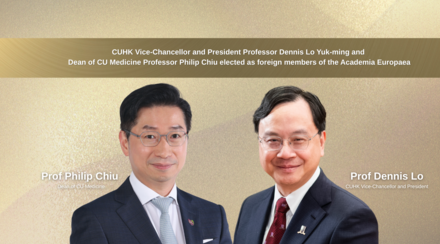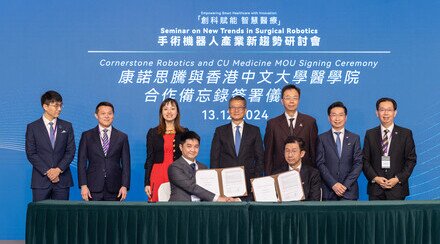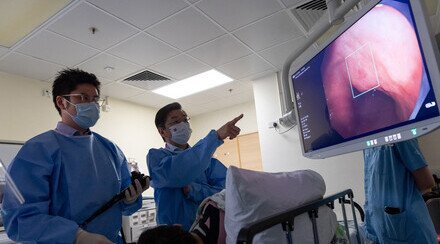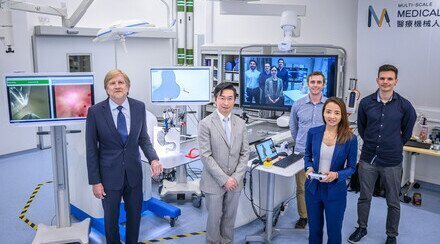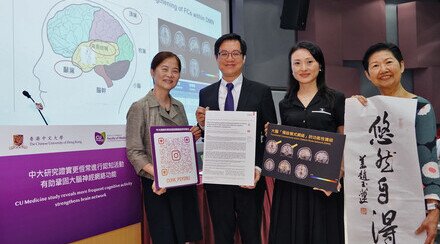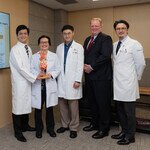CU Medicine receives the Li Ka Shing Foundation’s donation of Asia’s first Histotripsy 2.0 system 30 patients sponsored to receive novel treatment for liver tumours
The Chinese University of Hong Kong (CUHK)’s Faculty of Medicine (CU Medicine) has received Asia’s first Histotripsy 2.0 system as a donation from the Li Ka Shing Foundation (Foundation) which is serving patients in early 2025. Equipped with state-of-the-art hardware, Histotripsy 2.0 can accommodate more functions and support continuous system and software upgrades while offering more comprehensive and specific data that enable more precise focal therapy. The Foundation will sponsor 10 patients to receive this novel treatment, while CU Medicine and the Prince of Wales Hospital (PWH) Charitable Foundation will support another 20 patients, CU Medicine and PWH will lead clinical trials of Histotripsy for 30 liver cancer patients. The multi-disciplinary team of CU Medicine and PWH will commence clinical research to advance the application of Histotripsy to cancer treatment beyond liver tumours.
Enhancement of Histotripsy 2.0:
- Equipped with state-of-the-art hardware, accommodating more functions and supporting continuous system and software updates
- Offering more comprehensive and specific data
- Enabling more precise focal therapy
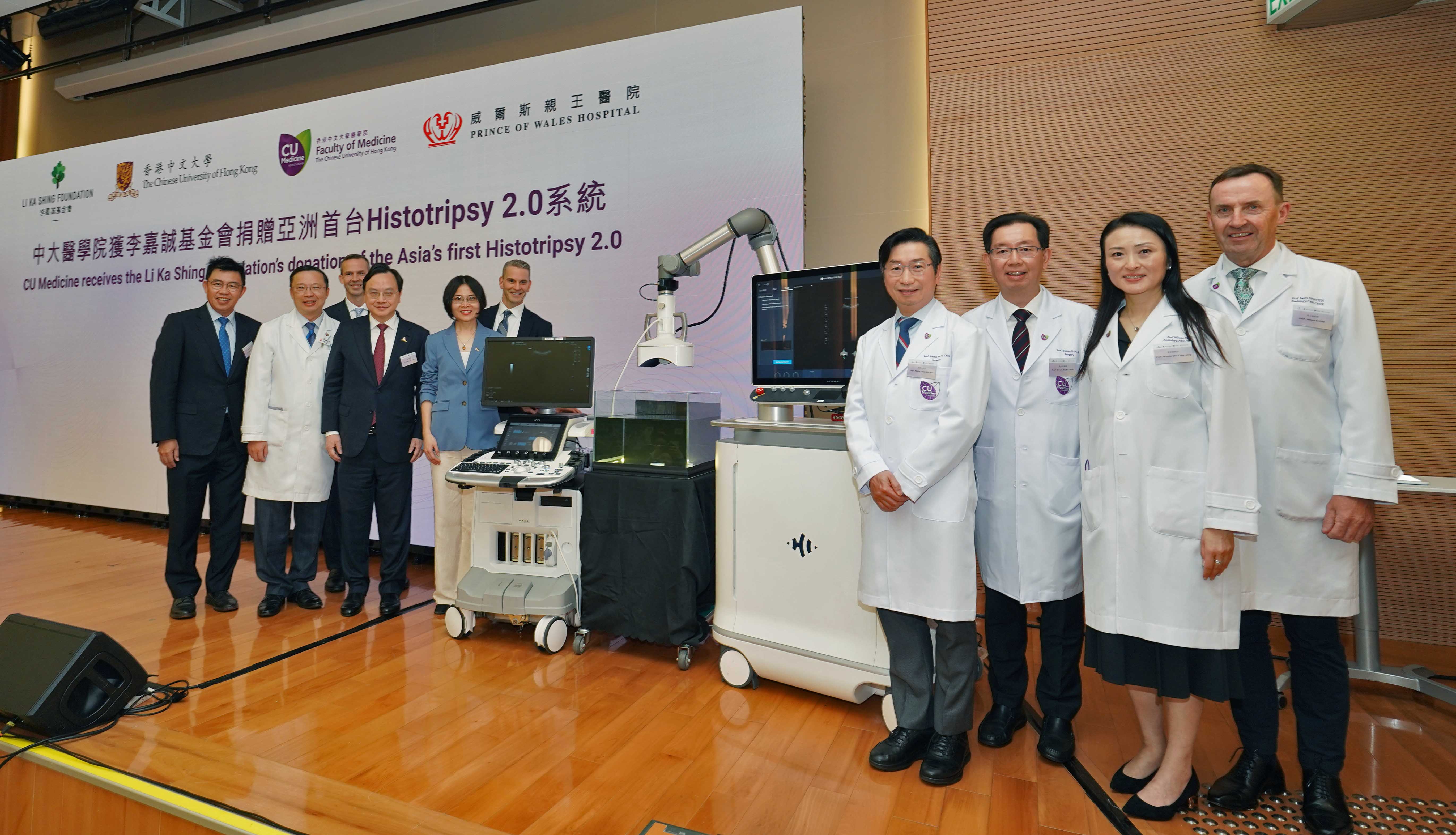
CU Medicine receives the donation of Asia’s first Histotripsy 2.0 system from the Li Ka Shing Foundation. CU Medicine and PWH will lead clinical trials of Histotripsy for 30 liver cancer patients in early 2025.
(From left) Dr Chung Kin-lai, Cluster Chief Executive of New Territories East and Hospital Chief Executive, Prince of Wales Hospital; Professor Anthony Chan Tak-cheung, Li Shu Fan Medical Foundation Professor of Clinical Oncology and CUHK’s Pro-Vice-Chancellor; Dr Joseph Herman, Chief Medical Officer, HistoSonics; Professor Dennis Lo Yuk-ming, Li Ka Shing Professor of Medicine and CUHK’s Vice-Chancellor Designate; Professor Zhen Xu, Professor of Biomedical Engineering, University of Michigan and main inventor of Histotripsy; Mr Mike Blue, President and CEO of HistoSonics; Professor Philip Chiu Wai-yan, Shun Hing Education and Charity Fund Professor of Robotic Surgery andDean of CU Medicine; Professor Simon Ng Siu-man, Wei Lun Professor of Surgery and Chairman, Department of Surgery, CU Medicine; Professor Winnie Chu Chiu-wing from CU Medicine’s Department of Imaging and Interventional Radiology; and Professor James Griffith, Chairman, Department of Imaging and Interventional Radiology, CU Medicine at the press conference.
The Asia’s first Histotripsy 2.0 enables more precise focal therapy
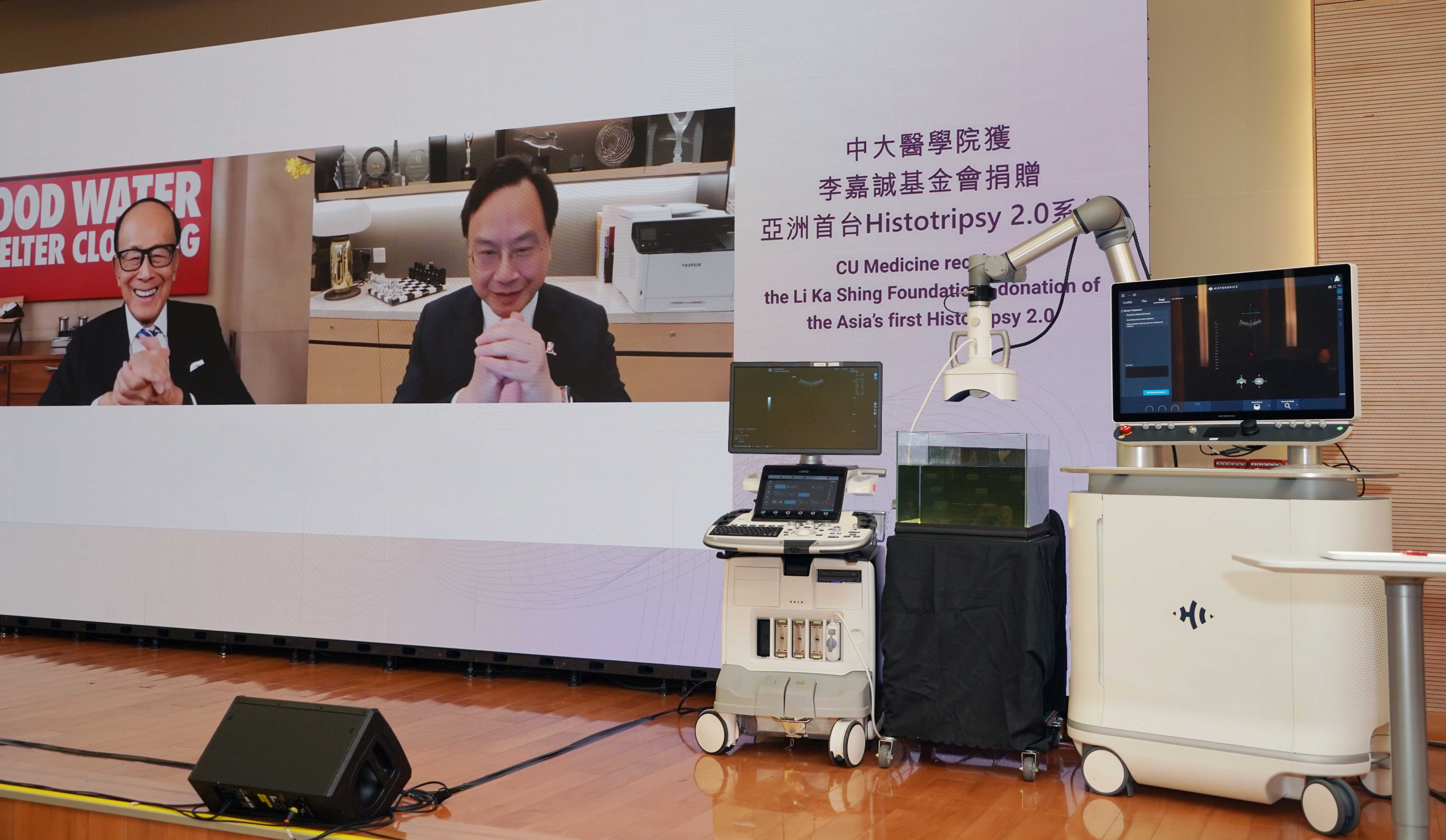
Mr Li Ka-shing, Chairman of the Li Ka Shing Foundation and Professor Dennis Lo,Li Ka Shing Professor of Medicine and Vice-Chancellor Designate of CUHK exchange thoughts on the donation of Histotripsy 2.0 via videoconferencing. Mr Li hopes that cost-effective and efficient medical technologies can significantly improve healthcare quality and develop a healthcare economy that serves Hong Kong, mainland China and Southeast Asia. Professor Lo expresses gratitude for Mr Li’s support of CUHK over the years and undertakes that CUHK will make this world’s leading, novel technology accessible to patients as soon as possible through studies and research.
Professor Dennis Lo,Li Ka Shing Professor of Medicine and Vice-Chancellor Designate of CUHK, thanked Mr Li Ka-shing and the Foundation for their support to CUHK. “As early as 2005, Mr Li made a substantial donation to establish the Li Ka Shing Institute of Health Sciences at CUHK. It has been my privilege to be the founding director and lead the Institute since then to chart a new course in medical research for the University, the Hong Kong community, and the wider Asian region. I am deeply honoured to serve as the ninth Vice-Chancellor and President of CUHK, and look forward to the continuous support of Mr Li and the Foundation to further CUHK’s contributions to education and research locally, nationally and globally.”
Professor Anthony Chan, Li Shu Fan Medical Foundation Professor of Clinical Oncology and Pro-Vice-Chancellor of CUHK, expressed gratitude to the Foundation: “Over the years, Mr. Li Ka-shing and the Foundation have always been supportive of CUHK's education and research development, and have made generous donations to support many CUHK's units and departments. The donation of Histotripsy will strengthen CUHK's clinical research capacity in cancer treatment and enable more patients to benefit from the world's cutting-edge medical technology.”
Professor Philip Chiu Wai-yan, Shun Hing Education and Charity Fund Professor of Robotic Surgery and Dean of CU Medicine stated: ‘‘We would like to express our sincere appreciation to Mr Li Ka-shing for the support to CU Medicine over the years, which have empowered us to scale new heights in medical innovation. CU Medicine has long been a pioneer in the research, development and introduction of state-of-the-art medical technology and devices. We aspire to provide patients with innovative clinical solutions, enabling safer and more effective treatment through multi-disciplinary collaboration. We are also very grateful for the donation from the Prince of Wales Hospital Charitable Foundation and the support of the PWH team in making histotripsy accessible to more patients.’’
Mr Li Ka-shing stated: “Since the first Histotripsy system arrived in Hong Kong, treatment for 30 patients with liver cancer has been successfully arranged in 90 days. This game-changing technology is a gift of hope, health and life. The promise and impact of this low cost, high efficacy option tremendously lessened the financial devastation on the patients and their families, and more importantly, the fiscal burden to the government health care services in our ageing society.”
Histotripsy 2.0 is equipped with next-generation hardware, capable of accommodating more functions by enabling continuous system and software upgrades. The system will enable even more efficient tumour ablation by providing more objective and continuous feedback of the ablation process, laying a solid foundation for the treatment of multiple kinds of cancer with the extended use of Histotripsy across different parts of the body.
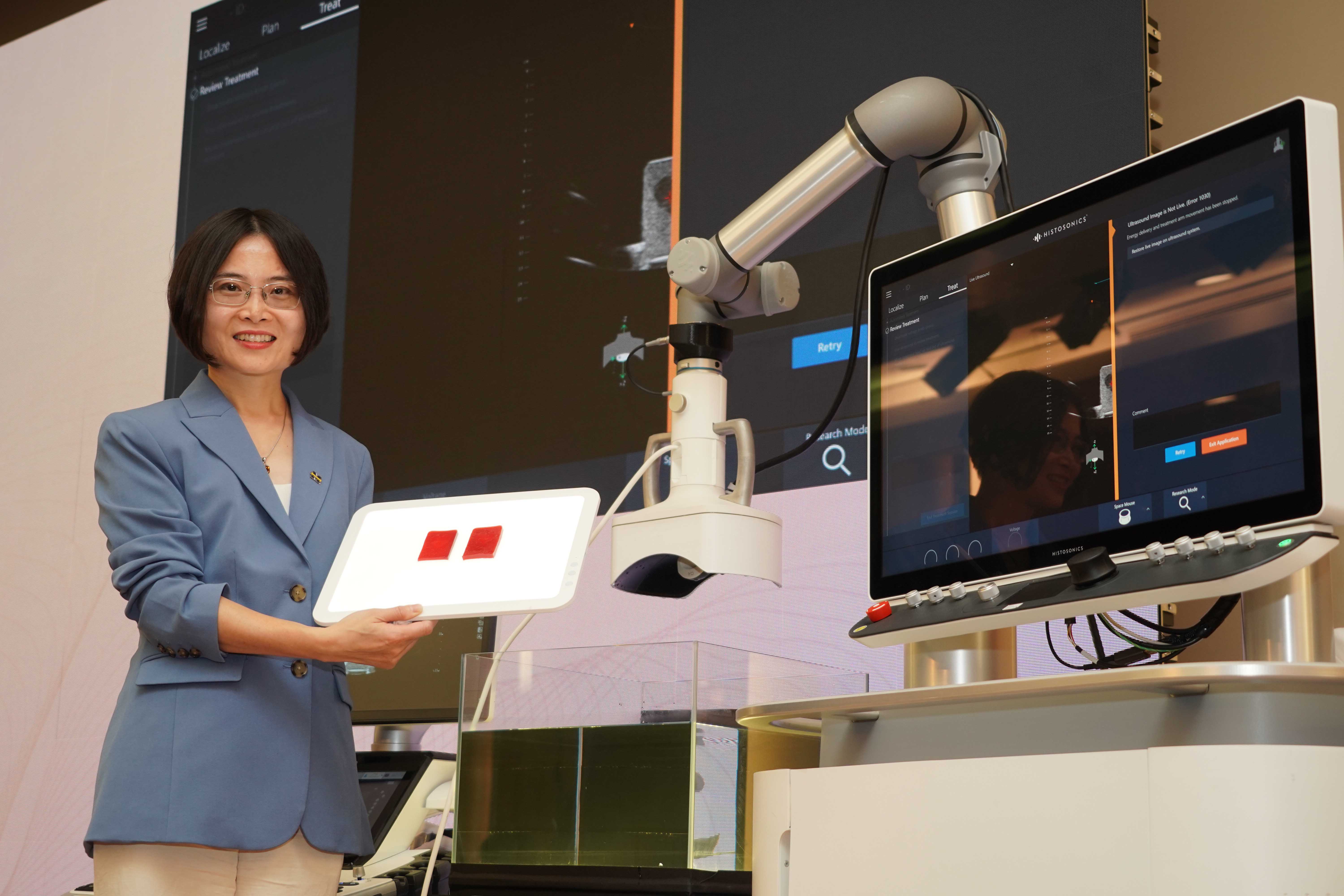
Featured is Professor Zhen Xu, Professor of Biomedical Engineering, University of Michigan and the main inventor of Histotripsy, with the Histotripsy system.
A new horizon for the treatment of multiple cancers enabled by breakthrough technology and multi-disciplinary efforts
Professor James Griffith, Chairman of CU Medicine’s Department of Imaging and Interventional Radiology, reflected that: “Histotripsy uses high-intensity ultrasound waves to disrupt and liquefy targeted tumour cells. Treatment takes as little as 10-15 minutes without damaging important surrounding tissues. No surgery is required, making it a safe, non-invasive and highly effective treatment option. For all medical specialities, personalised, precise treatment is the ultimate goal. Histotripsy is a timely non-surgical approach to cancer treatment, providing patients with an additional option that can destroy tumours in a targeted manner.’’
Professor Simon Ng Siu-man, Wei Lun Professor of Surgery and Chairman of the Department of Surgery at CU Medicine, added: ‘‘A CUHK-PWH clinical team has already successfully applied this novel technology in treating a patient with liver cancer, which demonstrated good post-operative recovery and satisfactory efficacy. Gathering experts from the Departments of Clinical Oncology, Surgery, and Imaging and Interventional Radiology, CU Medicine’s multi-disciplinary team is ready to study how this innovative technology can be adopted for the treatment of common cancers in Hong Kong, such as breast cancer.’’

Professor Simon Ng Siu-man, Wei Lun Professor of Surgery and Chairman, Department of Surgery, CU Medicine and Professor James Griffith, Chairman, Department of Imaging and Interventional Radiology, CU Medicine share how the technology of Histotripsy treats liver cancer patients and cite how CUHK-PWH team applied this novel technology in treating a patient with liver cancer.
Histotripsy shows tremendous potential in breast cancer treatment
According to the Hong Kong Cancer Statistics of 2022, breast cancer is the second most common cancer in Hong Kong. It is also the most common cancer type affecting women of most age groups. Lifetime breast cancer risk is one in every 14 Hong Kong women.
In recent years, the medical field has been hotly looking into the use of “focal therapy” as the future direction for breast cancer treatment, providing patients with treatment options other than surgery. Focal therapy is potentially suitable for early-stage breast cancer patients with small tumours without lymphatic spread. The advantages include the use of only local anaesthesia, and the ability to perform the procedure in an outpatient setting, resulting in quicker recovery and well-maintained breast appearance without surgical scars. It is non-toxic and can be used in conjunction with other treatments.
Professor Winnie Chu Chiu-wing from the Department of Imaging & Interventional Radiology of CU Medicine recognises that Histotripsy offers a highly desirable approach to breast cancer treatment: ‘‘Histotripsy therapy relies on ultrasound to localise cancer, which is particularly favourable to Asian and Chinese women who have a higher breast density than Caucasian women. Small breast cancers may not be detected by conventional mammography but can be identified through ultrasound. With further technical development, Histotripsy using high-intensity ultrasound waves can potentially be a promising emerging focal therapy option for offering a less invasive option for breast cancer patients who are not suitable for surgery or who decline traditional surgeries such as a mastectomy.”

With Histotripsy showcasing great precision in creating a heart-shape tissue with high-intensity ultrasound waves in the demonstration, Professor Winnie Chu Chiu-wing from CU Medicine’s Department of Imaging and Interventional Radiology recognises that with further technical development, Histotripsy can potentially be a promising emerging focal therapy option for offering a less invasive option for breast cancer patients.


